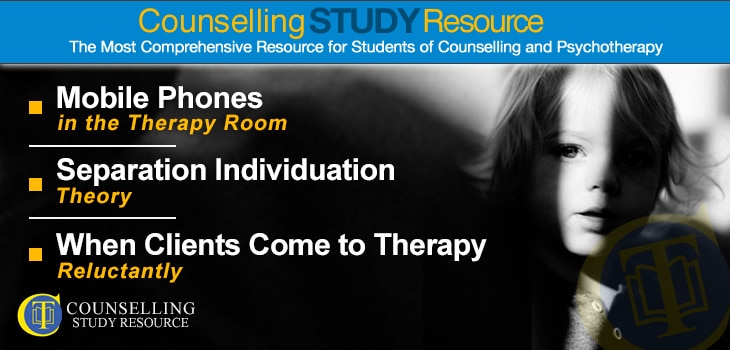054 – Mobile Phones in the Therapy Room – Separation Individuation Theory – When Clients Come to Therapy Reluctantly
In episode 54 of the Counselling Tutor Podcast, Ken and Rory discuss how to deal with clients who check their mobile phones during therapy sessions. ‘Theory with Rory’ explains Margaret Mahler’s separation individuation theory. Finally, the presenters discuss clients who come to therapy reluctantly – for example when they are sent by someone else, or when an initial enquiry about therapy services comes from a friend or relative of the potential client.
Mobile Phones in the Therapy Room (starts at 3.48 mins)
What would you do if a client kept checking their mobile phone during their counselling sessions? Rory and Ken discuss different ways of looking at this. Rory draws on the work of Catherine Knibbs, specialist in cybertrauma – she sees the mobile form as an attachment object for some people. Thus, it could be likened to having a third person present in the counselling room.
In counselling, it is always important to try our best to see the client’s world through their eyes – that is, from their frame of reference. For example, an older person may regard their phone as much less important than would a teenager.
However, if a client is using the action of checking their mobile phone as a way to distract themselves from feelings, and to avoid deepening the therapeutic relationship, then it would be important to challenge this, as part of the client’s process. Otherwise, it could prevent psychological contact.
Separation-Individuation Theory (starts at 12.13 mins)
This theory was developed by Hungarian-born psychiatrist Margaret Mahler. Born in 1897, Mahler worked also in the UK, and then in New York, USA. She died in 1985. Rory describes her separation-individuation theory.
During the initial four to six weeks of infancy, the child either sleeps or is barely conscious; this is sometimes known as the ‘normal autistic stage’. After this, the normal symbiotic phase begins, finishing at around five months of age; during this phase, the child experiences themselves as one with the mother. This links with the gestalt concept of confluence, which describes the situation where there is scarcely a boundary between two people.
In the normal separation-individuation phase, the infant starts to develop a sense of identity (that is, their own self-construct) as they start to engage with the wider environment and other people. Mahler proposed that there are three phases of separation-individuation:
- Hatching (at age five to nine months) involves the child becoming aware of differences between themselves and their caregiver, and of their surroundings: they want to explore but use the caregiver as a consistent object for emotional regulation.
- Practising (at age nine to 16 months) sees the child beginning to crawl then walk. The child is now active, and begins to explore and to become more independent of the caregiver, though has not yet realised they are fully separate people.
- Rapprochement (at 16+ months) sees the child becoming aware of their ability to be mobile and to separate psychologically from the caregiver, although still wanting to be able to see them as they explore the world. Mahler further divided rapprochement into three sub-stages: beginning, crisis and solution.
Mahler’s view was that anything that disrupts the process of separation-individuation can affect the youngster’s ability in later life to maintain a sense of individual identity. But if the separation-individuation process goes to plan, then the child learns object consistency, allowing them to balance their independence with their need for their caregiver.
Rory’s handout on Mahler’s separation-individuation theory is free to download via the button above. This topic has clear links with John Bowlby’s attachment theory, and there is a lecture on this (and another that draws on attachment theory in looking at grief and bereavement) which you can watch here.
When Clients Come to Therapy Reluctantly (starts at 21.30 mins)
Is it possible to counsel someone who has been sent along by someone else? Ken and Rory use Carl Rogers’ seven stages of process to discuss this issue. Even if the counsellor offers the core conditions, the other conditions that are necessary (and sufficient) for therapeutic personality change would not be met if the client is unwilling to engage in therapy and personal growth.
Rogers worked in Wisconsin with people who had schizophrenia; his observation following research with this group was that therapy will work with most people so long as they are motivated to change. Tony Merry, in his book Learning and Being in Person-Centred Counselling (PCCS Books, 2002), discusses the ethical problems when seeing a client who has not come to counselling voluntarily.
There is also a lecture on Rogers’ seven stages of process that you can watch here.


